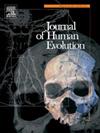人族手指骨的序列重建
IF 3.1
1区 地球科学
Q1 ANTHROPOLOGY
引用次数: 0
摘要
序列形态学是研究生物体中重复的、顺序排列的结构,重点研究它们的发育、组织和进化意义。灵长类动物的手指,表现出近远端和桡尺同源性,可以使用序列形态学方法进行分析。该方法为重建古人类化石记录序列元素提供了一种潜在的工具。因此,本研究旨在分析现存和已灭绝的人族物种近端和中间指骨的序列同源性,以验证一种重建手部缺失骨骼的新方法。为此,我们设计了一个II-V趾近端和中间指骨模板(27个真实标记和128个曲线半标记),应用于智人(n = 125)、尼安德特人(n = 9)、纳莱迪人(n = 9)、南方古猿sediba (n = 2)和类人猿(n = 122)。缺失数据的估计采用双边对称或几何估计方法。我们使用主成分分析来量化和检查每个指骨的形态变异。利用广义Procrustes分析、Procrustes距离、主成分分析和Mann-Whitney U检验,将估计的指骨与原始形态进行比较,对每个序列重建的指骨进行验证。结果突出了潘人与古人类序列同源性的相似性和差异性,反映了共同的发育“蓝图”以及受遗传和功能因素影响的种间形态差异。最后,用同源元素对古人类近端和中间手指骨进行序列重建是可能的,用近端-近端或中间-中间的定位更准确,为重建缺失的古人类手指骨化石提供了可能。本文章由计算机程序翻译,如有差异,请以英文原文为准。
Serial reconstruction of Hominini manual phalanges
Serial morphology is the study of repeating, sequentially arranged structures in organisms, focusing on their development, organization, and evolutionary significance. Manual digits in primates, exhibiting proximodistal and radioulnar homology, can be analyzed using a serial morphological approach. This method offers a potential tool for reconstructing serial elements of hominin fossil record. Therefore, this study aims to analyze serial homology in proximal and intermediate phalanges of extant and extinct Hominini species to validate a novel methodology for reconstructing missing bones within the hand. For this purpose, we designed a template (27 true landmarks and 128 curve semilandmarks) for proximal and intermediate phalanges of digits II–V, applied to Homo sapiens (n = 125), Homo neanderthalensis (n = 9), Homo naledi (n = 9), Australopithecus sediba (n = 2), and Pan troglodytes (n = 122). Missing data were estimated using bilateral symmetry or geometric estimation methods. We used principal component analysis to quantify and examine morphological variability for each phalanx. Each serially reconstructed phalanx was validated by comparing the estimated to the original morphology using generalized Procrustes analysis and Procrustes distances, principal component analysis, and the Mann-Whitney U test. The results highlight both similarities and differences in serial homology between Pan and hominins, reflecting a shared developmental ‘blueprint’ alongside interspecific morphological variations influenced by genetic and functional factors. Finally, serial reconstruction with homologous elements is possible in the proximal and intermediate manual phalanges of Hominini, being more accurate with a proximal-proximal or intermediate-intermediate disposition, offering potential for reconstructing missing fossil hominin manual phalanges.
求助全文
通过发布文献求助,成功后即可免费获取论文全文。
去求助
来源期刊

Journal of Human Evolution
生物-进化生物学
CiteScore
6.30
自引率
15.60%
发文量
104
审稿时长
3 months
期刊介绍:
The Journal of Human Evolution concentrates on publishing the highest quality papers covering all aspects of human evolution. The central focus is aimed jointly at paleoanthropological work, covering human and primate fossils, and at comparative studies of living species, including both morphological and molecular evidence. These include descriptions of new discoveries, interpretative analyses of new and previously described material, and assessments of the phylogeny and paleobiology of primate species. Submissions should address issues and questions of broad interest in paleoanthropology.
 求助内容:
求助内容: 应助结果提醒方式:
应助结果提醒方式:


